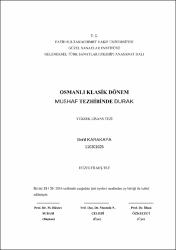| dc.contributor.advisor | Çelebi, Mustafa Nasuhi | |
| dc.contributor.author | Karakaya, Beril | |
| dc.date.accessioned | 2014-10-31T11:28:21Z | |
| dc.date.available | 2014-10-31T11:28:21Z | |
| dc.date.issued | 2014 | |
| dc.identifier.citation | KARAKAYA, Beril, Osmanlı Klasik Dönem Mushaf Tezhibinde Durak, Fatih Sultan Mehmet Vakıf Üniversitesi Güzel Sanatlar Enstitüsü Geleneksel Türk Sanatları (Tezhip) Anasanat Dalı, Yayımlanmamış Yüksek Lisans Tezi, İstanbul 2014 | en_US |
| dc.identifier.uri | https://hdl.handle.net/11352/2094 | |
| dc.description.abstract | Kültür ve sanat zenginliğini ve seviyesini gösteren kitaplar, medeniyetlerin aynasıdır. Kitapların ve levhaların yazıldığı hatlar seçilmiş örnekleri ve süslenmesinde kullanılan tezyini unsurlar ile ayrı ayrı önem taşırlar.
İslam'ın ilk yıllarında kutsal kitabımızı doğru bir şekilde yazma ve okuma çabası yerini daha sonra onu güzel yazarak süsleme çabasına bırakmıştır. Geç Emevî ve erken Abbasî döneminde (8.-10. yy. arasında) istinsah edilen Kur'ân nüshalarından anlaşıldığı üzere, sayfaları bezeme geleneğinin kutsal kitabın sayfalarında başladığı söylenebilir.
Tezimde, Kur'ân-ı Kerim'in indirilmesinden itibaren ayetlerin yazıya geçirilmesi, bunların daha sonra iki kapak arasında toplanması gibi konular ve Kur'ân-ı Kerim'in ilk tezhiplendiği zamandan günümüze kadar gelişen tezhip sanatı, kronoljik bir düzen içerisinde ele alınarak incelenmiş; müze,kütüphane ve özel koleksiyonlardan verilen bilgiler örneklerle desteklenmiştir.
Tezhip sanatı, dönemlerine göre kısaca ele alınmış, konu ve verilen bilgiler örneklerle süslenmiştir. Tezin konusu olan duraklara gelince, onlar, tanımları yapılarak çeşitlerine göre ayrılmış, dönemler bazında incelenerek ele alınmıştır.
Araştırma sırasında, Süleymaniye Kütüphanesi’nden oldukça yararlandım. Ancak bu, her zaman bu kadar kolay olmadı. İstediğim görsele ulaşamadığımda ise, değişik kaynaklar bulup, bunları tezimde kullanma yoluna gittim.
Durak Motifi, tezde, önce ona neden ihtiyaç duyulduğu ve bu motifin nasıl ortaya çıktığı konusundan başlayarak anlatılmıştır. Kur'ân-ı Kerim'de durakların yer aldığı şekiller ve nedenler anlatılmış ve duraklar dönemlere göre de incelenmiştir. | en_US |
| dc.description.abstract | Books that display the wealth and level of cultures are mirrors of civilization. The calligraphy samples used to write books and plaques and the enscrolled elements are all significant and necessary.
The attempts of writing and reading our holy book correctly of in the first years of the Islam were replaced later by the attempt of writing it beautifully and adorning it. As can be understood from the copies of Koran that were copied during the late Omayyad and the early Abbasid periods, in the 8th – 10th centuries, it can be pointed out that the tradition of decorating the pages with adornments started in the pages of the holy book.
In my thesis subjects such as the writing and putting together the Koran from the time it was started and the art of adornment developing from the first enscrollment times of the Koran up to today has been discussed chronologically and the resources regarding the subjects are presented with examples from museums, libraries and private collections.
The art of adornment has been investigated according to its periods and explained supported by examples. The caesuras that are the subject of my thesis have been described and separated according to their types and also examined and explained according to periods.
While ma ing the research for m thesis, I have benefited from the S le mani e Library museum pretty much. I was not able to access the works and benefit from them easily at all times, but as a result of my efforts, I found different resources and used them in my thesis.
The Caesura Motif has been explained firstly about why it was needed and how it came about in the beginning. The shapes and the reasons for the motifs in the Koran were discussed and investigated according to their periods.
Yours faithfully, | en_US |
| dc.language.iso | eng | en_US |
| dc.publisher | FSM Vakıf Üniversitesi | en_US |
| dc.rights | info:eu-repo/semantics/openAccess | en_US |
| dc.subject | Tezhip | en_US |
| dc.subject | Kur’ân-ı Kerim | en_US |
| dc.subject | Dura Motifi | en_US |
| dc.subject | Illumination | en_US |
| dc.subject | Koran | en_US |
| dc.subject | The Caesura Motif | en_US |
| dc.title | Osmanlı Klasik Dönem Mushaf Tezhibinde Durak | en_US |
| dc.type | masterThesis | en_US |
| dc.contributor.department | FSM Vakıf Üniversitesi, Güzel Sanatlar Enstitüsü | en_US |
| dc.relation.publicationcategory | Tez | en_US |
| dc.contributor.institutionauthor | Karakaya, Beril | |



















